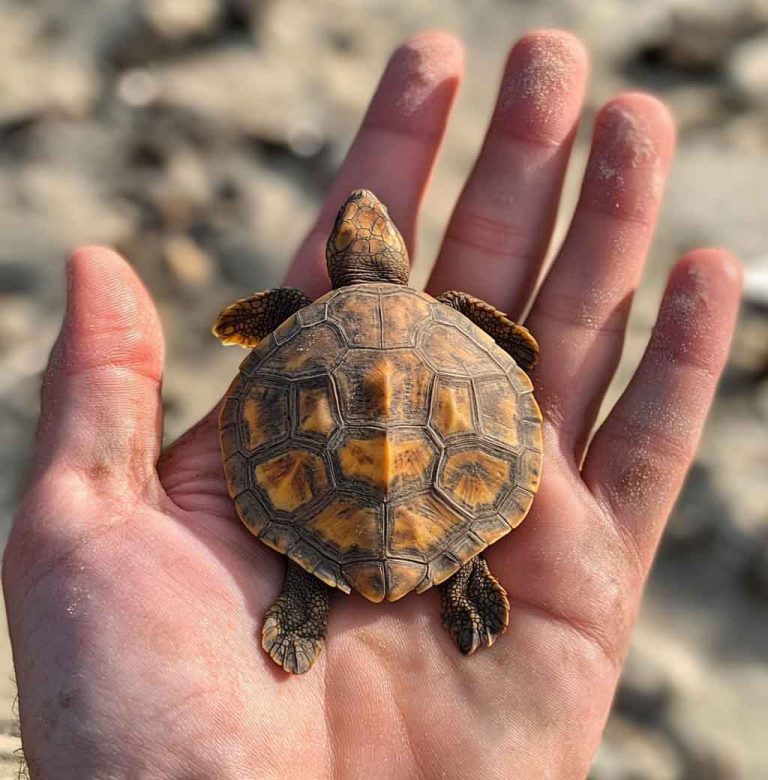Do Turtles Have Periods? – Everything There Is To Know!
Ever wondered if turtles get periods like humans do? Honestly, I did too when I first started caring for turtles. It might sound silly at first, but once you really start observing your pet — especially a female — it’s a legit question. You might see egg-laying behavior, mood shifts, or even what looks like…
Ever wondered if turtles get periods like humans do? Honestly, I did too when I first started caring for turtles. It might sound silly at first, but once you really start observing your pet — especially a female — it’s a legit question. You might see egg-laying behavior, mood shifts, or even what looks like spotting. So, naturally, you ask yourself: Do turtles menstruate like mammals?
Well, here’s the straight-up answer: No, turtles do not have periods. They don’t shed their uterine lining like humans. But they do have a reproductive cycle — and if you own a female turtle (or plan to), understanding how it works can make a huge difference in keeping her healthy and stress-free.
So, let me break it all down for you — from how their reproductive system works, to whether they can lay eggs without mating, and what signs you should actually watch out for.
Do Turtles Have Periods?
No — turtles do not get periods. Unlike humans or other mammals, turtles are reptiles. And reptiles have a totally different reproductive process.

In mammals, a female’s body prepares for pregnancy each month by thickening the uterine lining. If no pregnancy occurs, that lining sheds — and that’s what we call menstruation. But turtles don’t have that kind of internal cycle. Their bodies don’t build up and then discard tissue. Instead, female turtles develop eggs internally, and when the eggs are ready, they lay them — no bleeding involved.
Even when I was just getting started as a turtle parent, I noticed how calm and predictable the reproductive process is. There was no mess, no signs of what we’d call a “monthly cycle,” and definitely no blood. It’s fascinating how nature works differently depending on the species.
Can Female Turtles Lay Eggs Without a Male?
This part still surprises a lot of people — but yes, female turtles can and often do lay eggs without mating. These are called unfertilized eggs, and they will never hatch because no sperm is present. Still, to the naked eye, they can look just like the real thing.
I’ve had female turtles lay eggs randomly, sometimes during the warmer months, without ever being near a male. It’s actually quite normal. Their reproductive system is seasonal — meaning, during certain times of the year (usually spring and summer), their bodies respond to environmental triggers like light, heat, and hormones by producing eggs.
What’s more — some turtles will go through all the digging and nesting behaviors as if they were laying fertile eggs, even when they’re not. It’s instinct.
Important tip: If you keep a female turtle and notice her trying to dig or acting restless, she might be ready to lay. Make sure she has a proper nesting area — otherwise, she could become egg-bound, which is serious (I’ll explain more on that later).

What About Bleeding? Is That Normal?
Here’s where it gets a bit tricky — and honestly, this is one of the biggest reasons people assume turtles have periods.
Let me be clear: Bleeding is not a normal part of a turtle’s reproductive cycle. If you ever see blood around the cloaca (the opening near the tail), it’s a red flag. There’s no such thing as turtle menstruation — so any bleeding could mean injury, infection, parasites, or even internal egg complications.
I once had a female turtle show tiny traces of blood near her vent, and I panicked — thinking maybe I had missed something about how turtles reproduce. After a visit to a reptile vet, it turned out to be a minor infection. Luckily, it was caught early.
So here’s the rule: if you see blood, get it checked out. It’s not part of any “cycle” and shouldn’t be ignored. Reptiles hide illness well — and by the time you see symptoms like bleeding, it might already be advanced.
How Does a Turtle’s Reproductive System Work?
Understanding how your turtle’s reproductive system works is key — especially if you’re keeping a female. Trust me, it’ll save you a lot of guesswork and unnecessary stress down the line.
So here’s the basic idea: female turtles have ovaries and oviducts, just like birds. The ovaries produce eggs, and the oviduct is where the eggs are coated with albumin (a protein layer) and a leathery or calcified shell. Once formed, the eggs move toward the cloaca, and the turtle will look for a place to lay them.
Now here’s something most people don’t realize — the eggs don’t need sperm to form. Just like hens, turtles will produce and lay eggs regardless of whether a male is present. The only difference is that the eggs won’t be fertile if she hasn’t mated.
I always tell new keepers this: If you’ve got a female turtle and she starts acting restless, scratching at the corners of her tank, digging in her substrate, or refusing food, she might be preparing to lay eggs. It doesn’t mean she’s pregnant — just that her body is doing what it’s biologically built to do.

What Is Egg Binding and Why Should You Worry?
Now let’s talk about something serious: egg binding — also called dystocia. This happens when a female turtle is physically unable to lay her eggs. And believe me, it’s more common than you might think — especially in captivity.
I went through this once with my red-eared slider. She was digging for days, then stopped eating, looked lethargic, and started dragging her back legs weirdly. I knew something was off. A quick vet visit and X-ray later — she was egg-bound with four large eggs stuck inside.
What causes it? A few things:
- No proper nesting area (they need soft, moist substrate to dig)
- Poor calcium levels
- Dehydration
- Obesity
- Stress from handling or environmental changes
Symptoms to watch for:
- Restlessness or digging but no eggs
- Straining or tail lifting without results
- Loss of appetite
- Lethargy
- Swollen belly
If you even suspect your turtle is egg-bound, don’t wait. It’s painful and dangerous — and can even be fatal if not treated. A reptile vet can often induce egg-laying with injections or, in severe cases, surgically remove the eggs.

How Often Do Turtles Lay Eggs?
This totally depends on the species, age, environment, and whether mating occurred.
In general, most turtles lay eggs once or twice per year, usually during the warmer seasons — spring and summer. Even without a male, your female turtle might go through this cycle annually.
Some aquatic species like red-eared sliders, painted turtles, or cooters may lay 5–20 eggs at a time. Others, like box turtles or musk turtles, lay smaller clutches of 3–6 eggs. And let me tell you — a well-fed, healthy female in a warm environment will be a lot more likely to produce eggs than one kept in poor conditions.
One of my older female sliders still lays infertile eggs like clockwork every May. It’s just part of their rhythm.
FAQs About Turtles and Periods
1. Do turtles bleed when they lay eggs?
Nope — healthy egg-laying in turtles doesn’t involve any bleeding. If you see blood around the vent or in the nesting area, something could be wrong. It might be a sign of injury, egg binding, or even an internal infection. I always say — if there’s blood, get it checked. Better safe than sorry.
2. How can I tell if my turtle is gravid (carrying eggs)?
From my experience, a gravid (egg-carrying) turtle will start acting a bit different. You might notice:
- Restless digging behavior
- Decreased appetite
- Trying to escape the tank
- Kicking her back legs around like she’s trying to dig
- A slightly firm or rounded belly if you feel gently behind her back legs
If you’re unsure, a reptile vet can take an X-ray and confirm it easily.
3. Should I remove unfertilized eggs from the tank?
Yes, you should. Unfertilized eggs can rot quickly and grow mold, which can mess up the tank’s cleanliness. I usually remove them right after my turtle lays. Just be gentle and don’t disturb her while she’s still digging or laying — it can stress her out.
4. Can male turtles lay eggs or go through anything similar?
Nope — only female turtles lay eggs. Male turtles don’t have the reproductive organs for that. If you ever see a turtle laying eggs, that’s your confirmation it’s a female.
Tips for Helping a Female Turtle During Egg-Laying Season
From one turtle keeper to another, here are some must-know tips that have helped me a lot over the years — especially if you’ve got a female during her reproductive cycle:
- Give her a nesting box — Fill it with moist, soft substrate like damp soil, coconut coir, or a mix of topsoil and sand. I usually keep it warm and quiet.
- Watch her behavior closely — If she starts pacing, digging, or acting off, it could be egg-laying time.
- Keep her hydrated and calcium-fed — I dust food with a calcium supplement (with no phosphorus) and make sure she has clean water always.
- Limit handling — A stressed turtle may stop laying or get egg-bound. I try to let her be during this time.
- Call the vet if something feels wrong — You’ll learn to trust your gut the longer you keep turtles. If she’s straining or looks in pain, don’t wait it out. Get help.
Final Thoughts
So, do turtles have periods? No, they don’t — not even close. But that doesn’t mean their reproductive system is simple. Female turtles go through some big changes throughout the year, especially during laying season. Understanding these changes — and how to support them — is one of the best things you can do as a turtle owner.
I’ve learned over time that even though turtles seem calm and low-maintenance, they need care that’s thoughtful and tuned in. If your female starts showing signs of nesting, don’t ignore it. Give her the space and setup she needs, and she’ll thank you for it — in her own slow and steady way.
Thanks for stopping by — and if you want to learn more about turtle care, egg health, or habitat setup, feel free to check out my other posts. I’ve got you covered.







